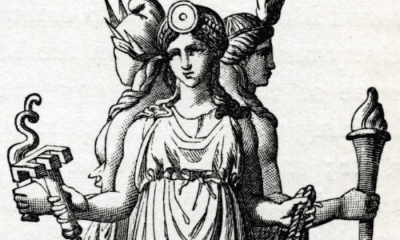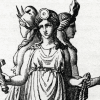Greek
The Horae: The Greek Goddesses of the Seasons
The Horae were the goddesses of the seasons, but did you know they also represented much more than times of the year? Read on to find out about the many roles of the goddesses of the seasons and the hours!
In the ancient world as today, farmers are not as concerned with the calendar as they are with if the weather is seasonal. The date is not as important as whether the temperature and rainfall are appropriate for planting, growing, and harvesting their crops.
An unseasonably cold spring, a wet summer, or an early frost can be disastrous for farmers. One of the most important things for them is that the seasons are the right length and come at the right time.
This is how the people of Greek viewed the Horae, the goddesses of the seasons. Their role was not just to personify the times of the year, but to make sure that they moved in the correct order and at the correct pace.
As goddesses of natural law, the Horae maintained the stability and order of life in Greece. As Greek society changed, so too did the Horae.
In some places and times, the Horae were almost unrecognizable as the three original goddesses of the seasons. In all cases, though, their main role was to maintain order and stability in the world.
The Goddesses of the Seasons and Time
The Horae were goddesses of the progression of time in Greek mythology. Their title could be translated as “The Seasons” or “The Hours.”
The Horae were traditionally seen as of particular importance to farmers because they controlled the progression of the seasons, and thus the cycle of agricultural work. Over time, however, their role became much more complex.
In the earliest tradition, there appear to have been only two Horae. Auxesia and Damia, the seasonal goddesses of summer and winter, were later only recognized in Argos.
In most of the Greek world, there were traditionally three Horae. They were usually said to be the daughters of Zeus and Themis, the goddess of law.
In the Iliad, these three goddesses of the seasons are the keepers of the cloud gate that leads to Olympus. This depiction is found nowhere else in classical literature, however.
Instead, the Horae were usually shown in charge of the seasons of the agricultural year. They were Thallo, the goddess of spring, Auxo, the goddess of summer, and Carpo, the goddess of autumn.
These three goddesses were responsible for making sure the three seasons came in the correct order and lasted the appropriate amount of time.
There was traditionally no goddess of winter. That time of year was controlled by Persephone and marked by her descent into and return from the Underworld.
The three goddesses of the seasons were often shown in the entourage of Persephone. They were also close companions of the Anemoi, the gods of the winds.
As daughters of Themis and Zeus, the Horae were associated with natural law and proper order. The marking of the seasons was done according to established, inviolable laws.
In time, this idea became more pronounced. A new group of Horae emerged that was more closely tied to these ideas of law.
Dike, the goddess of justice, Eunomia, the goddess of order, and Eirene, the goddess of peace, were sometimes worshiped as a triad of Horae, particularly in Athens. Their function was less concerned with the agricultural times of year than with the maintenance of proper order.
In the Athenian concept of law, these three goddesses personified the states necessary for society to function correctly. With these Horae keeping natural laws in place, time and society could both continue.
A more complex set of Horae were developed in later eras. After the introduction of the zodiac, these were no longer goddesses of seasons but of more precise measurements of time.
This was a group of twelve, each representing a calendar month. They also controlled the passage of individual hours, each being responsible for a time of day and a time of night.
My Modern Interpretation
The goddesses of the seasons in Greek mythology were among the most changeable and variable deities.
This is because they were not only goddesses of nature, but also of natural law. As the Greek view of this law evolved over time, so too did the goddesses who controlled it.
The earliest Horae were thought of at a time when Greece was a predominantly agrarian society. Specific times of day and even months did not matter to farming people as much as the broader patterns of weather.
For Bronze Age farmers, the individual months of the year were not natural laws that had to be noted. More important to them was the beginning of the planting season, the growth of summer, and the timing of the harvest.
The first three Horae, therefore, were agricultural goddess.
These were always important to Greece, as the majority of people were farmers throughout antiquity. To the philosophers of the cities, however, the seasons were not the most important laws.
In cities like Athens, the people did not rely on the seasons to ensure that their world was stable. Instead, they relied on the rule of law.
For them, the Horae were personifications of the elements needed to keep their society healthy and stable, just as the proper ordering of the seasons kept rural farmers’ lives more stable.
In the Classical Age, the emphasis on immutable and unchangeable law began to change. Rather than societal laws, the great thinkers of the age were interested in ideas of philosophy, mathematics, and the sciences.
They saw a different type of natural order in mathematical principles. Inspired by Byzantine astrology, they marked the stability of the year through uniform movements of time rather than broad periods.
The zodiac divided the year into twelve completely even and precise measurements, which perfectly complemented the twenty-four even divisions of the hours of the day. This kind of mathematical symmetry fit the new idea of natural law better than general seasons or broad concepts of societal law.
The Horae became goddesses not of the seasons, but of more specific divisions of time.
Other versions of the Horae existed at certain times and in certain places of the Greek world. Each was concerned with the proper ordering and progression of whichever natural laws seemed most important to the people there.
While the three traditional Horae were goddesses of the seasons, their more general role as goddesses of order and progression made them subject to change. The Horae could represent whatever form of order was needed to keep society stable.
In Summary
In Greek mythology, the Horae were goddesses of the seasons and the progression of time. As daughters of Zeus and Themis, they were representatives of natural law and the stability it brought.
In an agricultural society, the Horae ensured that the seasons moved at the correct pace and in the correct order. This allowed farmers to correctly time planting and harvesting their crops.
In places where most people did not work the land, however, this was not the most important type of structure and order.
The people of Athens and some other cities instead created another triad of goddesses they called the Horae. These were not goddesses of the seasons, but goddesses of law and the ordering of society in a more urban setting.
In time, the Horae changed again. As the study of natural law shifted to mathematics and the sciences, the goddesses of the seasons were again reinterpreted as deities of set months and times.
These twelve Horae were rooted in mathematical law rather than the needs of farmers. They marked the seasons not based on weather, but on a set structure that never changed.
The Horae were more than just goddesses of seasons. They were representatives of the progression of time and the structuring of the world and, as such, were adapted to fit the needs of different times and places.



